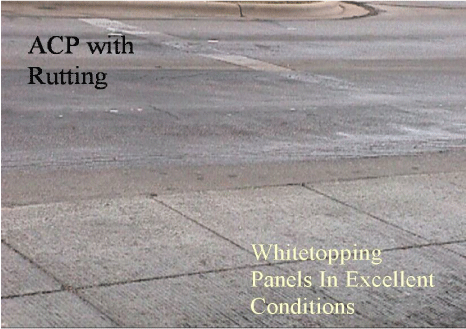Section 8: Thin Concrete Pavement Overlay (Thin Whitetopping)
Anchor: #i10161198.1 Introduction
Thin whitetopping (TWT) is a 4- to 7-in. thick concrete overlay bonded to an existing asphalt concrete pavement (ACP) to create a composite section (see Figure 8-7). TWT is constructed normally at intersections where rutting and shoving in asphalt pavement continue to cause problems. TWT may also be used at access or exit ramps to interstate highways, entire sections of urban roadways, low-volume rural roads, bus lanes, and parking areas. TWT provides better serviceability, longer service life, lower life-cycle cost, and improved safety.
This rehabilitation technique purposely seeks to bond the concrete overlay to the existing asphalt. The composite action significantly reduces the load-induced stresses in the concrete overlay. Therefore, the concrete overlay can be significantly thinner for the same loading as compared to a whitetopping section with no bond to the underlying asphalt. TWT will significantly reduce time and delays accompanying the frequent maintenance of an asphalt surface.
Figure 8-7. Whitetopping.
Anchor: #BSRVUFMP8.2 Guidelines for Thin Whitetopping (TWT)
The following guidelines provide the recommendations for TWT design thickness, joint spacing, ACP support layer, and better bond.
- Anchor: #PGTDFVXO
- Design Life of 5 to 10 yr. is recommended for TWT. Anchor: #AJQXGQBG
- Normally used at intersections where rutting and shoving in asphaltic pavement continue to cause problems. Anchor: #CYNKBESN
- Designs for < 4 in. TWT were not included because the initial cost difference between 4-in. slabs and those with less than 4 in. is negligible, and thinner slabs require shorter joint spacing, often encroaching on the wheel path. Anchor: #YSYAPOYL
- Designs for > 7 in. TWT were not included because our standard concrete pavement designs should be used along with load transfer devices. Anchor: #PDXXQBHO
- Contraction joint spacing is set at 6-ft. intervals to prevent edge loading and reduce the costs for saw cutting. All sawed TWT panels shall be square except as necessary in pavement width transitions. Anchor: #RTLBRKJQ
- Use engineering judgment to allow the contractor to meet plan requirements when using the ride specification at intersections or curb and gutter sections. Anchor: #OQBXAPOM
- Recommend ≥ 4 in. asphalt concrete pavement (ACP) support layer (including ASB and level-up). Anchor: #TUOSEOBV
- Uniform support will improve performance. Anchor: #JDOCOREP
- Recommend milling the existing ACP to provide a better bond and remove rutting ≥ 1/2 in. Anchor: #OAXYIJDW
- Opinions differ on the need for fibers to control shrinkage cracking. Anchor: #MNRVYKYG
- Saw cuts must be made as soon as possible, without delay. Anchor: #WMOIKCWG
- Saw-cut depths must be adjusted accordingly in thickened end sections. Anchor: #FVSNCDQJ
- At bridge approaches, an approach slab is recommended with an expansion joint as shown in existing standards. Anchor: #BJWOPIWU
- The department has yet to establish when expansion joints are needed for wide pavements. Anchor: #LOSJGFID
- The use of steel fibers is not recommended at locations where de-icing salts may be used. Anchor: #UMOWPRQN
- Apply governing Special Specification, Thin Whitetopping (Concrete Overlay). Anchor: #XIKEHUKM
- Use Thin Whitetopping Details, TWT-04 Standard Sheet. Anchor: #GIIUTBYN
- Use Table 8-8 as a general guide for determining proper TWT thickness. More research will be conducted to improve the design procedure.
|
Trucks per Day per Lane |
Design Life (yr.) |
|||||
|---|---|---|---|---|---|---|
|
5 |
6 |
7 |
8 |
9 |
10 |
|
|
≤ 200 |
4 |
4 |
4 |
4 |
4 |
4 |
|
250 |
4 |
4 |
4 |
4 |
5 |
5 |
|
300 |
4 |
4 |
4 |
5 |
5 |
5 |
|
350 |
4 |
4 |
5 |
5 |
5 |
5 |
|
400 |
4 |
5 |
5 |
5 |
5 |
5 |
|
450 |
5 |
5 |
5 |
5 |
5 |
6 |
|
500 |
5 |
5 |
5 |
5 |
6 |
6 |
|
600 |
5 |
5 |
5 |
6 |
6 |
6 |
|
700 |
5 |
5 |
6 |
6 |
7 |
7 |
|
800 |
5 |
6 |
6 |
7 |
7 |
7 |
|
900 |
6 |
6 |
6 |
7 |
7 |
n/a |
|
1,000 |
6 |
6 |
7 |
7 |
n/a |
n/a |
The traffic data (in terms of ADT, Percent Directional Distribution, and Percent Trucks) are obtained from the traffic analysis report provided by TPP.
Trucks per day per lane = ADT × PDD × PT × LDF
Where:
- Anchor: #YUMPAVQW
- ADT = average daily traffic for the first year of design period Anchor: #XYYALVGG
- PDD = percent directional distribution of traffic (assume 50% split, unless observation proves otherwise) Anchor: #CXVUGOCW
- PT = percent trucks Anchor: #MULOMBYH
- LDF = lane distribution factor; use 1.0 for 4 lanes or less, 0.7 for 6 lanes, and 0.6 for 8 lanes or more. The lane number is for both directions.
Example:
- Anchor: #IKPHCHYC
- Design Life = 10 years, ADT = 13,500, PDD = 63%, PT = 3.0%, and 4 lanes roadway, LDF =1.0 Anchor: #YOXTRSEU
- Trucks per Day per Lane = 13,500 × 0.63 × 0.03 ×1.0 = 255 Anchor: #WPBJETMC
- For 255 trucks per day per lane and 10-yr. design, the required TWT thickness is 5 in.
